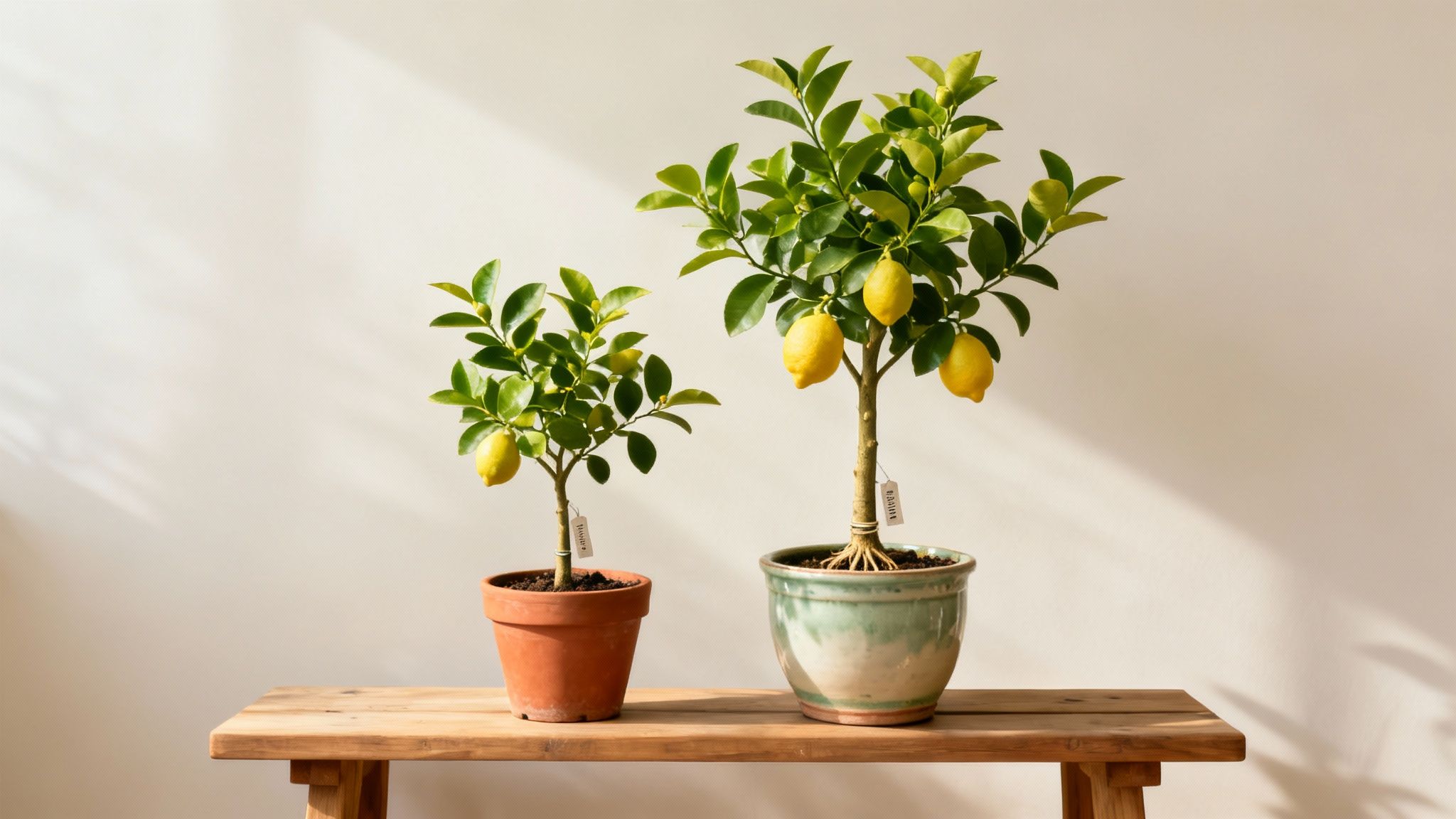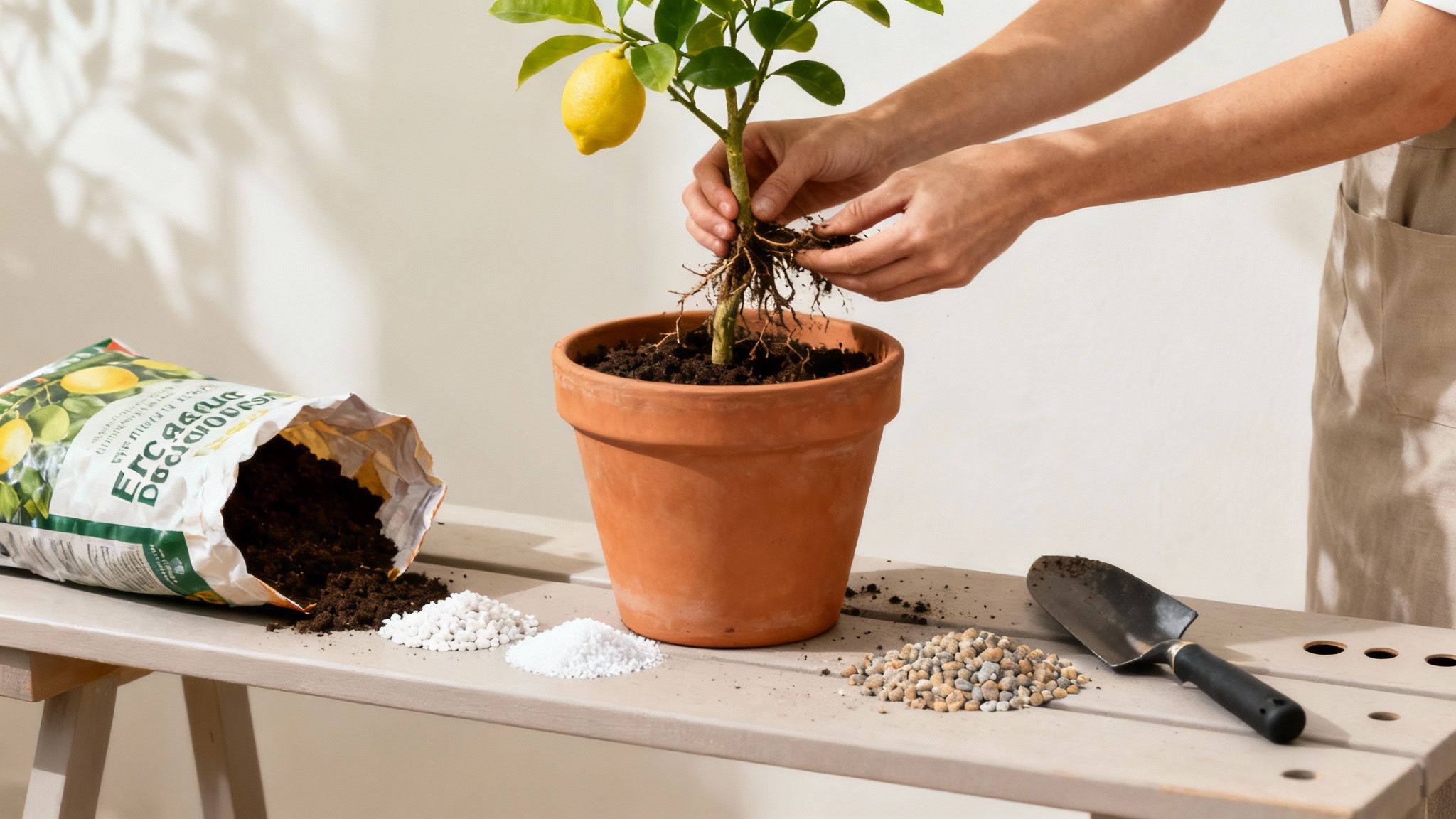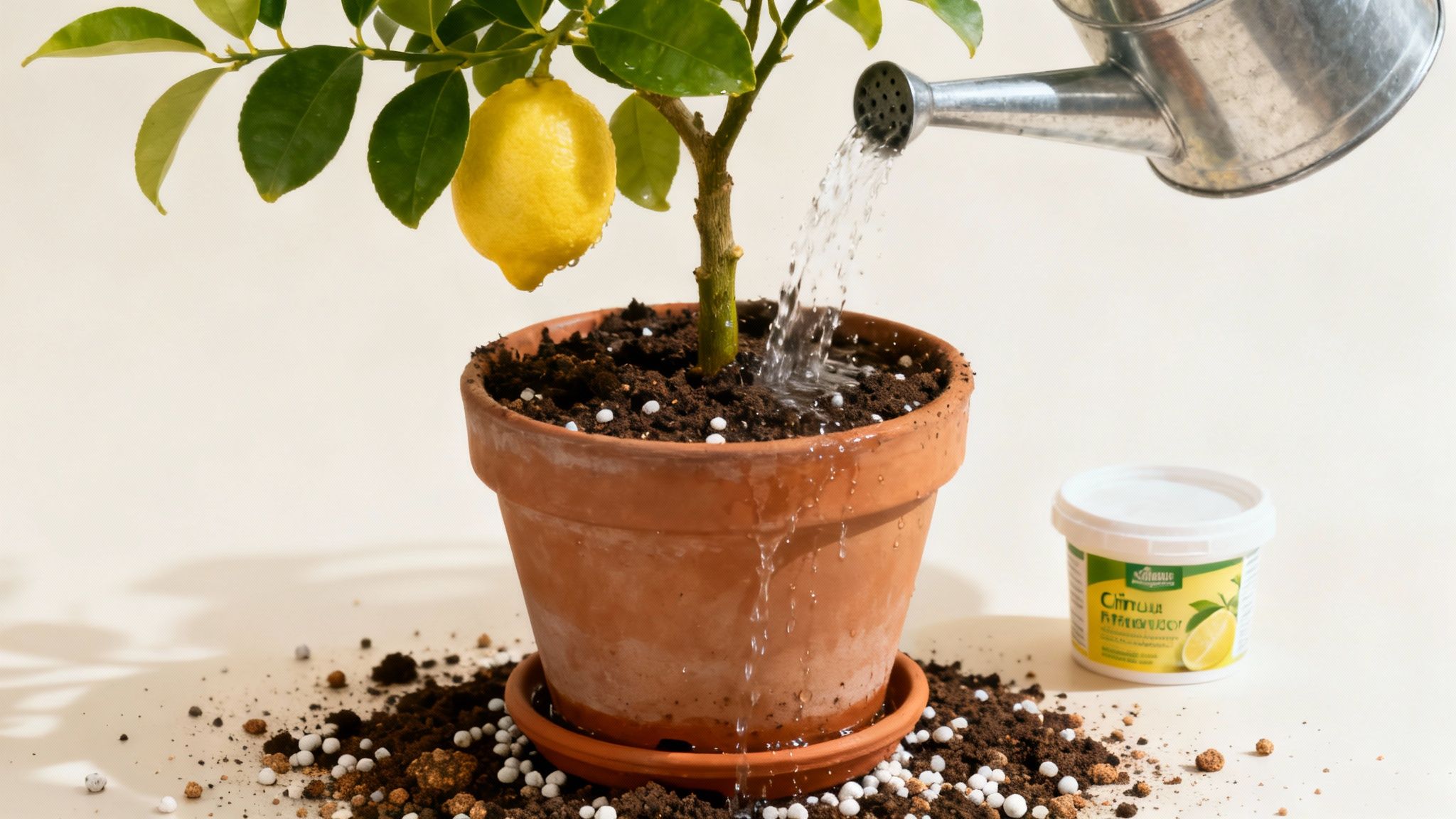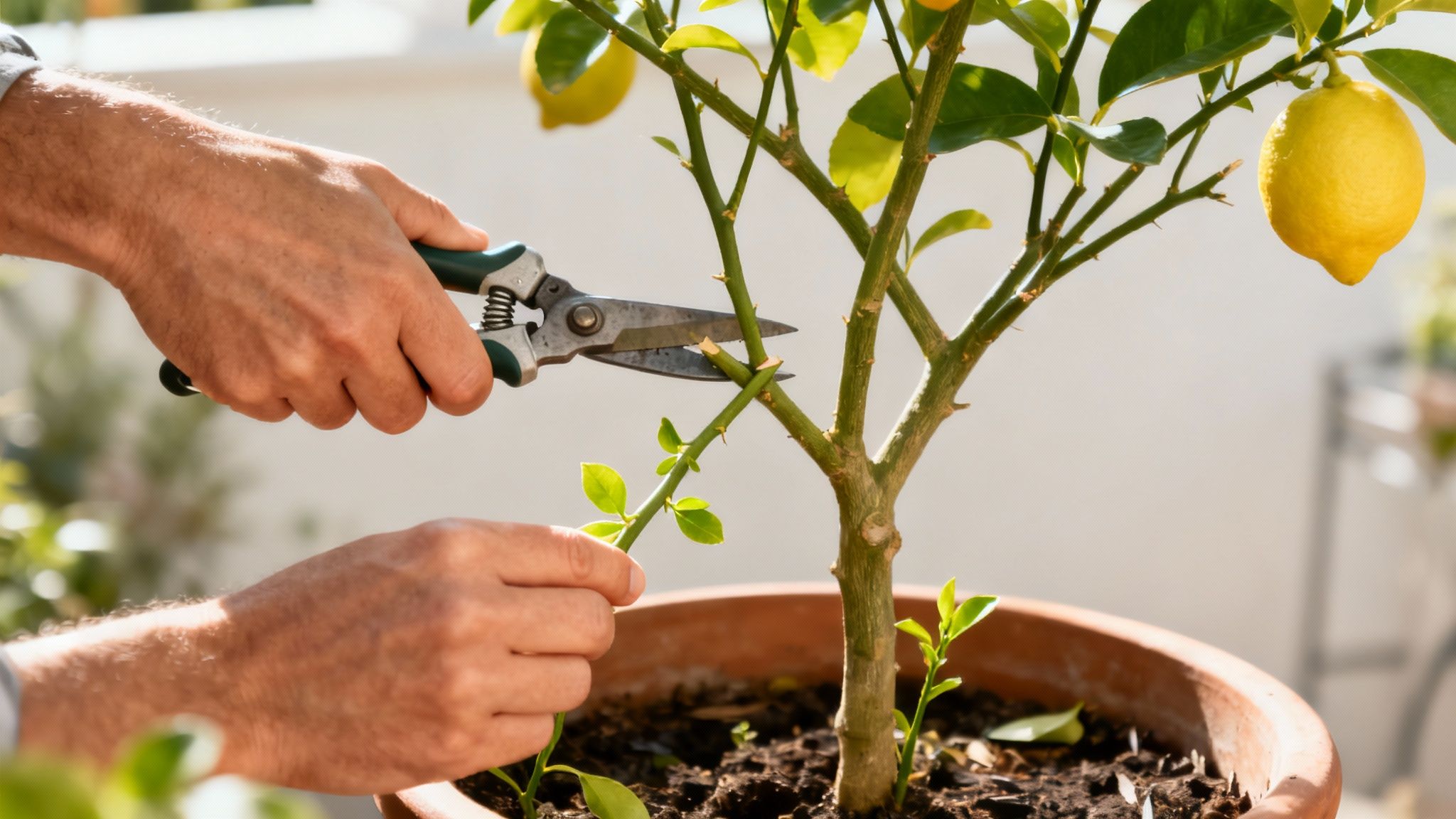To grow a lemon tree successfully, start by choosing a hardy variety suited to a pot, using a well-draining citrus compost mix, and providing at least eight hours of daily sunlight. This simple approach gives your tree the best foundation for thriving, even in cooler climates.
Choosing the Right Lemon Tree for UK Success

Growing your own lemons in the UK might sound like a challenge, but I promise it's more achievable than you think. Our climate isn't exactly Mediterranean, that's true. But growing your lemon tree in a container is the perfect workaround, giving you the power to move it indoors and protect it when the winter weather really bites.
Believe it or not, we have a long history of growing citrus here. Centuries ago, grand estates had purpose-built orangeries to shield lemons (Citrus × limon) from the frost. It’s a great example of British horticultural grit, and we’re just adapting those same principles for our own gardens and patios today.
Finding Your Perfect Lemon Variety
So, where do you start? The most critical decision you'll make is picking a variety that can actually cope with the British climate. Not all lemon trees are the same, and some are far more forgiving of our cooler, damper conditions than others.
To help you decide, here’s a quick comparison of a few popular varieties that do well in pots here in the UK.
Lemon Variety Comparison for UK Growers
Each of these has its own charm, but for most people just starting out, the ‘Meyer’ lemon is a brilliant choice. It’s actually a hybrid—part lemon, part mandarin orange—which gives it a slightly sweeter taste and makes it more cold-tolerant. Its naturally compact habit is perfect for pot life.
Another solid option is the ‘Eureka’, a classic, vigorous variety that will give you plenty of those sharp, thick-skinned lemons you find in the shops.
No matter which one you fall for, make sure you buy a grafted tree from the nursery. This means the top part of the tree (the bit that produces the lemons you want) has been joined to the tough, hardy root system of a different citrus plant.
Why a grafted tree is a must: Grafted trees are a shortcut to success. They can start producing fruit within just 2–3 years. A tree grown from a seed? You could be waiting a decade or more, and there's no guarantee it will ever fruit at all.
What to Look For at the Nursery
When you’re at the garden centre, don’t just grab the first tree you see. A few minutes of inspection now will save you a lot of headaches later. This choice is just as vital as the care you'll give it, a bit like when you learn how to grow a cherry tree from a strong, healthy sapling.
Here are the signs of a robust young tree ready for a new home:
- A strong, sturdy trunk that’s free from any scrapes, splits, or weird-looking patches.
- Vibrant, deep green leaves. They should have a nice gloss to them and be free from yellowing, spots, or any lurking pests (check the undersides!).
- A healthy root system. You don't want a tree that’s ‘root-bound,’ with roots tightly circling the pot. If you can, gently check the drainage holes to see if any light-coloured, healthy-looking roots are visible.
Taking the time to choose a healthy, grafted tree in a variety that suits pot life is the single most important thing you can do. It sets you up for a thriving plant that will reward you with fragrant blossoms and, eventually, your very own home-grown lemons.
Giving Your Lemon Tree the Best Start

So, you’ve brought your new lemon tree home. That first potting is one of the most important things you'll do for it. Get this right, and you're setting your tree up for years of healthy, happy growth and, hopefully, plenty of fruit. It’s more than just chucking some soil in a pot; this is about building a solid foundation for its entire life.
I’m a big advocate for terracotta pots. While plastic is lighter, terracotta is porous, which means air and moisture can pass through the clay. This is brilliant for preventing the soil from getting waterlogged—a fast track to an unhappy citrus tree.
Whatever you choose, make absolutely sure it has ample drainage holes at the bottom. Without them, water pools around the roots, and root rot will set in. It’s a nightmare to fix, so it’s best avoided from the start. A good rule of thumb is to pick a pot just a couple of inches wider than the one it came in.
Getting the Soil Mix Just Right
Lemon trees are a bit fussy about where their roots live. They need a soil that's slightly acidic but, most importantly, drains really well. Your standard multi-purpose compost is often too heavy and holds far too much water for their liking. For that reason, I always mix my own.
This is my tried-and-tested recipe for every citrus tree I’ve ever planted:
- 2 parts Ericaceous Compost: This gives you the slightly acidic base that lemon trees need to properly take up nutrients.
- 1 part Perlite: These little white volcanic rocks are fantastic for creating air pockets, which is key for improving drainage and stopping the soil from becoming compacted.
- 1 part Horticultural Grit: This adds a bit of weight and structure, but its main job is to help that water drain away freely from the roots.
Just tip everything into a wheelbarrow or a big bucket and give it a thorough mix. You're aiming to create something that feels a bit like the gritty, free-draining soil they'd find in their native environment.
Whatever you do, don't be tempted to just dig up soil from your garden. It’s far too dense, can bring pests along for the ride, and simply won’t have the right structure for a container plant. Getting the soil right is a fundamental lesson, which you can read more about in our guide to container gardening for beginners.
Potting Up Like a Pro
With your pot and perfect soil mix at the ready, it's time to get your tree settled into its new home. The key here is to be gentle and minimise any stress.
First, pop a few crocks (broken bits of terracotta work a treat) over the drainage holes. This stops all your lovely new soil from washing out every time you water. Add a decent layer of your soil mix to the bottom of the pot.
Next, carefully ease the tree from its nursery pot. A gentle squeeze on the sides usually helps loosen it. Support the base of the stem as you slide it out. Take a quick look at the roots—if they’re circling tightly around the bottom (what gardeners call 'root-bound'), gently tease the lower ones apart with your fingertips. This encourages them to grow out into the fresh compost.
Now, place the tree in the centre of its new pot. You want the top of its root ball to sit about an inch below the rim. And this is critically important: find the graft union on the trunk. It looks like a knobbly, diagonal scar near the base. Make sure this stays well above the soil level. If you bury it, you’re risking collar rot.
Finally, fill in around the sides with your soil mix, gently patting it down to get rid of any big air pockets. Give it a really good water until you see it running out of the bottom. This helps settle everything in and gives the roots a proper drink to welcome them to their new home.
Nailing the Watering and Feeding Routine

When you're learning how to grow a lemon tree, it's a classic case of killing with kindness. I’ve seen it time and time again—the most common mistake gardeners make is overwatering. It suffocates the roots and opens the door to a whole host of problems. The real secret is to stop following a rigid schedule and start listening to what your tree is telling you.
Your lemon tree’s needs will change dramatically throughout the year. A tree in a terracotta pot on a sun-baked patio in the middle of a July heatwave is going to be far thirstier than the same tree tucked away in a cool conservatory in February. That’s precisely why a fixed "water every Tuesday" routine just doesn't work.
Get to Grips with the Drench and Dry Method
The best way forward is what I call the 'drench and dry' method. It sounds simple, and it is, but it’s incredibly effective. Before you even think about reaching for the watering can, you need to check the soil.
Just push your finger about two inches down into the compost. If it feels damp, walk away. If it feels dry at that depth, then it's time to water.
When you do give it a drink, do it properly. Pour water slowly and evenly over the entire surface of the soil until you see it running freely from the drainage holes at the bottom of the pot. This makes sure the entire root ball gets a good soaking. After that, leave it well alone until the top layer has dried out again.
This simple cycle of a deep drench followed by a proper drying-out period is the best defence against root rot, which is the number one killer of container-grown citrus trees. It prevents the roots from ever sitting in soggy, waterlogged soil.
The Art of Feeding a Hungry Lemon Tree
Watering is only half the story. Lemon trees are notoriously hungry plants. To fuel all those fragrant blossoms and, ultimately, the juicy fruits, they need a regular supply of the right nutrients. Your standard, all-purpose plant food simply won’t do the job.
You really need to invest in a specialist citrus fertiliser. These have been formulated with the perfect balance of nutrients that lemons crave, especially during their main growing season from spring right through to late summer.
- Nitrogen (N): This is the fuel for growing lush, green leaves. If your tree's leaves start looking pale or yellow, a lack of nitrogen is often the culprit.
- Phosphorus (P): Absolutely essential for developing a strong, healthy root system.
- Potassium (K): This is the magic ingredient for encouraging flowers and, most importantly, for developing the fruit itself.
- Magnesium (Mg) & Iron (Fe): These are vital micronutrients. A magnesium deficiency is a common cause of yellowing between the leaf veins, a condition known as chlorosis.
To get a good crop from lemons grown in the UK, a consistent routine is everything. Most experts agree that feeding monthly during the growing season and only watering when the top inch of soil is dry are the key practices for a successful harvest.
Always follow the instructions on your chosen fertiliser, but as a general guide, plan to feed your tree every one to two weeks from March to October. You can then scale this back to once a month over the winter, or stop completely if the tree is in a very cool spot and has stopped actively growing. While a specialist feed is your best bet, you can also explore creating your own nutrient solutions by reading our guide on homemade plant food. Getting this balance of water and food right is what separates a lemon tree that just about survives from one that truly thrives.
Pruning and Shaping for More Fruit and Better Health

Pruning can feel a bit daunting, I get it. But trust me, it’s one of the most satisfying parts of looking after a lemon tree. This isn't about giving your plant a harsh haircut; think of it as strategic shaping. Good pruning encourages a stronger, healthier plant that puts its precious energy into making fruit, not just more leaves.
The best time to get your secateurs out is in the early spring, just before that main flush of new growth really kicks off. This timing is perfect because the tree heals quickly and channels its energy into producing new, productive branches. Getting the season right is a key gardening skill, and you can learn more about the best time to prune fruit trees in our detailed guide.
What to Look For When Pruning
Your main goal here is to create a light, open structure. You want sunlight and air to reach every single part of the tree. This simple act drastically reduces the risk of fungal diseases and helps all the lemons ripen evenly. It’s a bit like decluttering a room to let the light in.
When you start, you’re on the lookout for a few specific things. These are the non-negotiable cuts that will immediately boost your tree's health:
- Dead or Damaged Wood: Anything brown, brittle, or obviously broken should be the first to go. It’s just sapping energy from the plant.
- Crossing Branches: Spot any branches that are rubbing against each other? This friction can create wounds that become an open invitation for disease. Remove the weaker of the two.
- Suckers: Keep an eye out for vigorous, fast-growing shoots sprouting from the base of the plant (below the graft line). Snip these off right away, as they steal nutrients from the main tree.
Always use clean, sharp secateurs or pruning shears. A clean cut heals much faster and is far less likely to get infected than a ragged tear from a blunt tool. This small detail makes a huge difference to your tree's wellbeing.
Techniques for a Bushier Tree
Beyond just cleaning things up, you can also prune to shape your tree. This helps keep it compact and bushy, which is ideal if you're growing it in a pot on the patio. One of the easiest ways to achieve this is by pinching back new growth.
Throughout the growing season, simply use your thumb and forefinger to pinch off the very tip of a new, soft green shoot. This clever little trick encourages the branch to send out side-shoots, creating a fuller, more rounded shape instead of a few long, leggy stems. It’s a gentle but effective technique that gives you great results over time.
Your Winter Survival Guide for UK Lemon Trees
https://www.youtube.com/embed/voUugWB8fY8
Let's be honest, the UK winter is the biggest challenge you’ll face when growing a lemon tree. These citrus plants truly despise having cold, damp roots and being blasted by frosty winds. Nailing your winter strategy is the key to ensuring your tree doesn’t just survive, but bounces back with real vigour come spring.
The magic number you need to watch for is 5°C. As soon as nighttime temperatures start consistently dipping to this level, it’s time to move. Don't wait around for the first frost warning; the goal is to prevent cold stress entirely, not just react to it. This proactive approach keeps your tree healthy and helps it ease into its dormant period.
Bringing Your Lemon Tree Indoors
For most of us gardening in the UK, bringing a potted lemon tree into a protected spot is the safest bet. The ideal location is somewhere cool but bright. Think of an unheated conservatory, a bright porch, or even a shed or garage with a good-sized window. These spots do a great job of mimicking the gentle winter dormancy they'd experience in their native climate.
It’s always tempting to bring your prized tree into a warm, centrally heated living room, but this is almost always a mistake. The combination of dry air and much lower light levels is a recipe for stress, often causing the tree to drop its leaves and making it a target for pests like spider mites.
Your aim for winter isn't to encourage new growth, but to help the tree rest. A cool, bright spot allows it to enter a state of dormancy, conserving energy so it's primed for a burst of growth in the spring.
Protecting an Outdoor Tree
If you happen to live in a milder part of the UK, like Cornwall or along the south coast, you might get away with leaving your tree outside. Even so, it will still need some serious protection to get through the coldest snaps.
- Location is Everything: Tuck the pot up against a sunny, south-facing wall. The brickwork will absorb heat during the day and radiate it back through the night, creating a much-needed warmer microclimate.
- Insulate the Pot: The roots are incredibly vulnerable. Wrap the pot in a few layers of bubble wrap or hessian sacking to protect them from freezing solid—this is often more damaging than the cold air itself.
- Use Horticultural Fleece: On nights when a frost is forecast, cover the entire tree with a layer or two of horticultural fleece. This simple jacket can make a difference of several crucial degrees.
For a deeper dive, our guide on protecting plants in winter has a wealth of other practical tips.
Remember, your tree’s needs change completely during this dormant period. You’ll need to cut right back on watering—only give it a small drink when the top few inches of compost feel bone dry to the touch. You also need to stop feeding it altogether from around October until March. Overwatering or feeding a dormant plant is the quickest way to cause root rot, undoing all your hard work.
Answering Your Top Lemon Tree Questions
Even the most seasoned gardeners run into a few snags on their lemon tree journey. Don't worry—figuring out what your tree is trying to tell you is all part of the fun. Let’s tackle some of the most common issues you're likely to face and get your plant thriving again.
It's perfectly normal for your tree to have its ups and downs. The trick is to observe carefully and act thoughtfully, not panic.
Why Are My Lemon Tree Leaves Turning Yellow?
Yellow leaves are probably the number one headache for citrus growers, but the fix is often surprisingly simple. My first guess is usually a nutrient issue. When you're growing in pots, the good stuff in the compost gets used up or literally washed out the bottom over time.
A lack of magnesium or iron is a classic cause of yellowing between the leaf veins, a tell-tale sign of chlorosis. This is exactly why using a fertiliser made specifically for citrus is a game-changer. These are packed with the micronutrients lemon trees crave, so be sure to feed your tree regularly from spring through autumn.
But hold on—before you reach for the fertiliser, stick your finger in the soil. The other prime suspect is overwatering. If the roots are constantly sitting in soggy, waterlogged compost, they can't breathe, let alone absorb nutrients. It doesn't matter how much you feed it if the roots are drowning. Always, always let the top couple of inches of compost dry out completely before you water again.
My Tree Flowers but Never Fruits. What’s Wrong?
This one is incredibly frustrating. Your tree puts on a stunning display of fragrant blossoms, and then… nothing. They just drop off. It’s a common problem, especially for trees that live indoors.
So, here's the thing: lemon trees are self-fertile, but they still need a little help moving pollen around the flower. Outside, the bees and a gentle breeze handle this perfectly. Indoors, that job falls to you.
You can easily play the role of the bee. Just take a small, soft paintbrush or even a cotton bud and gently swirl it around the centre of each flower. Move from blossom to blossom, and you’ll be transferring the pollen. This simple, two-minute job can make all the difference.
Another potential culprit is stress. Lemon trees are a bit like fussy house guests; they don't like sudden changes. A surprise cold draught, a sudden move to a much sunnier spot, or an erratic watering schedule can stress the tree into dropping its flowers or baby fruit. Consistency is your best friend. A stable environment and a predictable care routine give your tree the security it needs to set fruit.
How Do I Deal with Sticky Leaves and Pests?
If you've noticed a clear, sticky film on the leaves or on the floor beneath your tree, you’ve found honeydew. This is the calling card of sap-sucking pests like aphids or scale insects. They drink the plant's sap and excrete this sugary goo.
Thankfully, your first line of defence is simple and doesn't involve harsh chemicals. Grab a cloth, dip it in a mild solution of washing-up liquid and water, and just wipe down the leaves and stems. This gets rid of most of the pests and cleans off that sticky mess. You might find little brown bumps called scale insects, which are a bit more stubborn. You can often just scrape them off gently with your fingernail.
Making a habit of checking your tree every week or so is the best prevention. Pay close attention to the undersides of leaves and where the branches meet the main stem—pests love to hide there. Catching them early is far easier than dealing with a full-blown infestation. Remember, a healthy, happy tree is always your best defence against pests.




